Introduction
The use of statistics to determine waste management approaches is an effective method of determining and informing the critical decision on public policies and environmental management practices. Consequently, the Environment Accounts and Statistics Division of Statistics Canada has become a critical body for collecting, analyzing, and providing trends and practices on waste management in Canada. The institution offers a complete set of data on waste management across different cities in Canada. The public can obtain accurate and reliable data about the Waste Diversion Policy from the organization. It provides data based on ongoing activities in municipalities, which allow local authorities to obtain current and historical data for effective decision-making and budgeting on waste management.
There are two major players in waste management in Canada. These include the business sector and the government through its local authorities. Both entities provide waste management services to the public. Hence, they have the necessary data required for studies related to human resources, employment trends, types of wastes, sources of waste, expenditures, revenues, and other relevant information about the industry. Both the government sector and the business sector provide services related to the collection and transportation of wastes for reuse or recycling, managing both hazardous and non-hazardous wastes, transfer of waste station, and waste treatment. They also provide information on waste diversion.
William Mueller has observed that waste recycling has become a critical element, as more wastes are generated (Mueller, 2013). Policymakers have the daunting task of choosing the best recycling practices to ensure the effective diversion of wastes from landfills. Consequently, the waste diversion has increasingly become a vital element of solid waste management across many cities globally. In this regard, Ontario Province had adopted a waste diversion act to enhance the management of solid wastes. Ontario’s Waste Diversion Act, 2002 aims to “promote the reduction, reuse and recycling of waste through the development, implementation, and operation of waste diversion programs” (Ministry of the Environment, 2008). In short, the Act focuses on reducing waste materials that go into landfills.
Ontario’s Waste Diversion Act 2002 strives to reduce the number of waste materials that go into the landfill. On this note, the present report evaluates the outcomes of waste management in Ontario in order to provide a conclusion on the effectiveness of the policy. This would result in the effective use of resources for waste management in Ontario.
To understand the effectiveness of Ontario’s Waste Diversion Act, 2002, the Environment Accounts and Statistics Division of Statistics Canada has become a critical body for collecting, analyzing, and providing trends and practices on waste management in Canada. Statistics Canada gathers data on waste management from private companies and the government through its local authorities because they have the necessary data required for studies related to waste diversion in Ontario and other provinces in Canada.
The second objective of this report is to assess programs and policies of waste diversion in Ontario Province by analyzing data collected between the years 1996 and 2010. The results would be useful for effective decision-making for waste diversion in Ontario and other parts of the world.
Literature Reviews
Incinerators, landfills, and other traditional methods of managing waste materials are no longer effective as cities generate huge amounts of wastes while the landfill capacities in Ontario have reached their limits. Consequently, they are hard-pressed to look for alternative ways of managing waste materials, particularly solid wastes, and other hazardous wastes. This calls for effective disposal of wastes through planning and controlling them in an economical and environmentally friendly manner.
Reddi and Inyang (2000) noted that engineers could only optimize waste disposal if there were adequate resources for developing effective landfill siting rather than spending resources to turn a poor site to a landfill. Today, solid waste management has experienced changes as new forms of wastes, technologies, and regulatory frameworks emerge. For Ontario, which has depended on landfills to manage solid waste materials, it must develop its landfill technologies to manage toxic wastes.
Waste management should address various methods of transforming solid wastes from various sources, such as households, institutions, farms, and other institutions, to use manure and other products (Pavoni, Heer, & Hagerty, 1975). On this note, it is imperative to develop new integrated solid waste management systems that can handle composting and wastes for landfills and transform them into useful products. Such a system assumes multipurpose capabilities and changes biodegradable waste materials into compost. It can enhance waste diversion and reduce the number of solid wastes for landfill.
Scholars, such as Diaz, Savage, Eggerth, and Golueke (1993) have focused on the importance of solid waste management programs and resource recovery as a part of making waste materials useful. Diaz et al. (1993) noted that the Municipal Solid Waste management should also focus on key steps, which are necessary for waste processing for diversion, material recovery, and generation of soil manure, marketing of recyclable materials, composting and promoting composting through integrated waste management strategies.
Typically, as the number of city dwellers increases, the amounts of waste materials increase steadily. This translates to a significant challenge for a clean environment because the production of waste has exceeded what nature can handle while depletion of resources also rises considerably (American Public Works Association, 1961).
Over the years, Ontario has generated millions of tonnes of solid waste materials (this has reached 9.3 million tonnes by 2010 from 6.9 million tonnes in 1996). However, a small portion of this waste is recycled or diverted while the rest goes to the landfill or incineration. Williams (2005) focused on understanding waste process engineering and disposal strategies. According to Williams, different technologies could offer the best solutions for both household and industrial waste materials (Williams, 2005).
A critical waste management effort should evaluate environmental laws, sources of wastes, their composition, characteristics, storage, collection, and transportation. Overall, using technologies to process solid wastes would help in reducing, recycling, reusing, safe disposal, and management. In addition, technologies would help in controlling landfill leachate and gas by detecting any anomalies. According to Shah, these processes are important for any civil engineers or scientists, who work in the waste management field (Shah, 2000).
The traditional methods of managing wastes are no longer effective because the municipal landfills have reached their limits. For instance, environmentalists claim that it is no longer practical to bury solid wastes due to two critical reasons. First, landfills are full. Second, environmentalists have claimed that buried solid wastes contaminate groundwater, which is a fundamental source of water for human consumption. Therefore, once such wastes contaminate the groundwater, it becomes difficult to purify, expensive, or even impractical to clean it up completely. It is also practically impossible to burn all solid wastes today.
The process of incineration produces energy with massive consequences. For instance, it releases dangerous gases into the atmosphere. Moreover, the final product is ash, which requires disposal into the landfill. The ash may also be hazardous. In short, many cities no longer have enough space for waste disposal (American Public Works Association, 1961). Further, it is also becoming difficult to find any outlying regions in which residents can accommodate the idea of introducing a new landfill. In most cases, such ideas meet stiff opposition. As local authorities and private businesses struggle to cope with their wastes in terms of costs and disposal, they are unlikely to accommodate wastes from other regions because of associated pollution and costs (American Public Works Association, 1941).
Landfill Disposal
Available literature (MacBride, 2013; Ministry of the Environment, 2008; van Haaren, Themelis, & Goldstein, 2010; Mueller, 2013) was reviewed on recycling and waste diversion practices in Ontario and other cities such San Francisco.
For Ontario, which has depended on landfill sitings to manage solid waste materials, this option is no longer viable due to a lack of suitable locations and large volumes of waste materials. In fact, the purpose of Ontario’s Waste Diversion Act, 2002, is to reduce the volume of solid waste materials that end up in landfills. Currently, the Conference Board of Canada has noted that Ontario has continued to rely on the US landfills in New York State and Michigan to manage its solid waste materials (Conference Board of Canada, 2014). Noble had noted that landfill siting was a significant component of solid waste management and disposal, but it was imperative to choose the best location, as far as possible from residential areas (Noble, 1992). A landfill selection process should rely on available information and management resources to ensure that the process is effective and acceptable to communities, environmentalists, and other stakeholders.
Today, solid waste management has experienced changes as new forms of wastes, technologies, and regulatory frameworks emerge. Ontario must, therefore, adapt to these changes in solid waste management, specifically by diversion. Diaz et al. (1993) had argued that solid waste management programs and resource recovery should turn wastes from cities such as New York into useful materials. The authors noted that Municipal Solid Waste (MSW) management should encourage collection with a particular focus on recycling and reuse (Diaz et al., 1993). These practices may lead to sustainability, which is the effective utilization of natural and technological resources in order to meet current and future needs.
Some past incidents have shaped the way people manage solid wastes in cities. For instance, the case of Love Canal attracted the public attention and concerns about the importance of regulations and dangers of pollution (McBean, Farquhar and Rovers, 1994). It is imperative to understand existing studies on solid waste management and landfill practices with the aim of solving issues associated with leachate, landfill gas, and enhancing procedures for operating landfills. Thus, solid waste management organizations should understand waste decomposition, the relevance of the landfill design, critical operational features, and the general improvement of the system due to any changes (McBean et al., 1994).
At the same time, it is essential for solid waste management teams to understand all issues that relate to the environment, particularly the quality of drinking water, and the released gas from the landfill. McBean et al. (1994) noted that methodologies exist to allow engineers, planners, and hydrogeologists to predict the release of landfill gas and the generation of leachate. This would allow them to design landfills that meet operational standards and protect the environment.
Each person must play a critical role in promoting sustainability for the future generation. The process of sustainability should start at homes, schools, and then to commercial and industrial settings. This may result in significant changes, which could help in protecting the environment. Many cities and communities have already introduced such programs through various initiatives (American Public Works Association, 1961).
Oweis and Khera (1990) noted that solutions to effective waste management could be in geotechnology approaches, which focused on relevant, current information on sensitive issues and areas of study and real-world practices. According to these authors, waste management practices should not only account for leachate and landfill gas, but also include other elements like solid waste properties, behaviors, and settlement characteristics. In addition, landfill designers must also evaluate “the site, geosynthetic features, erosion controls, caps, gas detection, management, foundation, and slope stability, and applicable regulatory guidelines” (Oweis and Khera, 1990) to determine its effectiveness.
Waste Diversion in Ontario, Canada
As Ontario residents and commercial entities continue to generate huge amounts of wastes, landfill sitings can no longer accommodate such waste materials. During the 1980s, the Province had already started to grapple with challenges of managing solid wastes due to limited capacities of landfills. This resulted in initiatives to promote recycling through business and community efforts. Such strategies focused on changing the laws and regulations on soft drinks. However, the idea got support from a few environmentalists, while majorities continued to support a deposit and return model. This marked the introduction of the Blue Box program for waste diversion in Ontario.
Today, many Ontario residents associate waste diversion with the Blue Box. The Blue Box has served as a waste collection point for kerbside recycling. As the numbers of city residents continue to increase, the volume of solid waste has also increased tremendously. The declining landfill sites, the increasing volume of solid, hazardous wastes, pollution, and costs of managing such wastes have led to fundamental questions, which resulted in the introduction of the Waste Diversion Act, 2002. The Act has transformed how Ontario manages and recycles its solid waste today. The Act’s history provides insight into waste management activities before and after its enactment.
In some instances, many organizations have noted that it is costly to develop and implement an effective waste diversion plan (Ontario needs to scrap its Waste Diversion Act, 2013). However, the 3Rs have failed to focus on the producers of wastes because of the alleged weaknesses of the waste diversion framework. Instead, the framework has concentrated on generators of wastes to facilitate diversion (Ministry of the Environment, 2008).
According to the Ministry of the Environment (2008), the rates of waste diversion among industries, commercial bodies, and institutions are strikingly low at 12 percent. Further, the Ministry noted that these were the major generators of solid wastes, but they only diverted only “12 percent of the total waste they generated in 2006” (Ministry of the Environment, 2008). On the other hand, in 2006, the Waste Diversion Ontario estimated that residential diversion rates had reached 38 percent (Ministry of the Environment, 2008).
The Conference Board of Canada recently indicated in its report of 2014 that Ontario only managed to divert 47 percent of residential waste and only 11 percent of non-residential while the overall rate of waste diversion was 23 percent (Conference Board of Canada, 2014). Relative to other major cities globally, Ontario has a low rate of waste diversion, for instance, San Francisco diverts 80 percent of its waste materials while Berlin diverts 40 percent (MacBride, 2013). Low rates of waste diversion have attracted the attention of critics (Recycling Council of Ontario and Ontario Waste Management Association) that have called for the removal of the Act.
Many municipal solid wastes originate from non-residential areas. Hence, residential wastes constitute a small percentage of MSW. However, such waste materials contain hazardous elements, which require diversion from landfills, transfer, water sources, energy sources, and the environment. Consequently, city authorities promote hazardous waste collection programs alongside residents in order to divert wastes and improve the collection of household hazardous wastes (Statistics Canada, 2004).
Although Worrell and Vesilind (2011) focused on regulatory frameworks, they emphasized the importance of solid waste engineering. According to these authors, engineering principles should guide solid waste management in a real-world situation (Worrell and Vesilind, 2011).
With careful consideration, the Conference Board of Canada (2014) has noted that better waste management should lead to recycle or reuse a huge portion of the generated wastes that end in the landfill. In turn, there would be a significant reduction in waste materials for landfills, job creation, less dependency on the US landfills, and a boost for Ontario’s economy.
Williams (2005) has argued for an integrated waste management practices that consist of waste-to-energy incineration, gasification, pyrolysis, anaerobic digesters, and composting for improved results. Ontario, perhaps, disposes of huge volumes of waste materials because of poor diversion practices.
The Province of Ontario has recognized that waste diversion is challenging because of its complex nature and, therefore, may not be easy to sustain. As a result, Ontario’s Waste Diversion Act, 2002, strives to reflect the importance of environmental laws and regulations through its 3Rs as ways of protecting natural resources and the environment and therefore promoting environmental sustainability. In addition, it has also taken an interest in reducing the number of wastes generated, preventing pollution, and utilizing resources effectively to protect the environment (Ministry of the Environment, 2008).
The collection of waste materials from both residential and commercial sources has played an important role in the integrated approach to solid waste management across Ontario. Such programs focus on any wastes that could be corrosive, flammable, toxic, or even reactive. These waste materials may include chemicals used in farms, pool, cleaning, paints, fluorescent bulbs, glue, and batteries, among others.
According to the Ministry of the Environment (2008), huge volumes of municipal solid wastes originate from non-residential areas in Ontario. Hence, residential wastes constitute a small percentage of solid wastes. However, such waste materials contain hazardous elements, which require diversion from landfills, transfer, water sources, energy sources, and the environment to ensure environmental protection and sustainability.
Ontario Province authorities, alongside residents, promote waste collection programs in order to divert wastes and improve collection. These are programs, which aim to maximize waste collection, reduce environmental risks, and enhance community safety, welfare, and health. Over the past few decades, local authorities have developed their waste management programs to meet increased waste generation per capita in Ontario with a focus on sustainability. Hence, waste generation, collection, and disposal have become ongoing practices, which require effective management and good facilities.
Sustainability practices, therefore, require the use of applied science and engineering principles to study, design, and implement critical aspects of solid waste management based on waste characteristics, recycling, reuse, storage, treatment, hazard, and contamination (Reddi & Inyang, 2000).
The Current Waste Diversion Framework in Ontario
The current Waste Diversion Framework (Figure 1) in Ontario focuses on industrial, commercial, and institutional domains to facilitate waste diversion. These are the major waste producers in Ontario, but with poor diversion practices (Ministry of the Environment, 2008). These domains or divisions within the framework have significant responsibilities in managing and diverting wastes in Ontario. They rely on the 3Rs (Reduction, Reuse, and Recycling) under the Environmental Protection Act to achieve the aim of waste diversion. Under the Act, waste generators must make reasonable efforts to separate and promote recycling of wastes (Ministry of the Environment, 2008).
There have been several initiatives to encourage waste diversion through regulatory frameworks such as Blue Box; technical and financial aid such as e-waste management, eco fees, and Continuous Improvement Fund; public education such as waste sorting out wastes; and manufacturing of recyclable materials such as environmental friendly bags and reusable plastics (Canadian Institute for Environmental Law and Policy, 2008).
It is vital for industrial, commercial, and institutional sectors to develop waste management plans, keep data, and audit their waste management activities. These are fundamental data, which help the government to understand waste dynamics in Ontario, develop policies, and allocate resources based on them. The approach should also aim to promote a culture of waste diversion in Ontario through major industries, commercial entities, and institutions. The fundamental aim is to ensure that many organizations adhere to standard waste management practices.

According to figure 1, the government drives Ontario Waste Diversion efforts and, therefore, major stakeholders who generate waste materials have been excluded from the diversion efforts. Consequently, the current framework has led to the poor diversion of waste materials (about 25 percent of 12 million tonnes generated), lost chances for investments, innovation, and conservation of resources, landfills declining capacities; and rising costs of the program (Government of Ontario, 2013).
The Need for a New Framework
Some of the stakeholders, such as the Recycling Council of Ontario (RCO) and Ontario Waste Management Association (OWMA), have called for the scrapping of the current waste disposal act (Ontario needs to scrap its Waste Diversion Act, 2013). These two organizations have asserted that the current framework has failed to account for the role of waste producers, and therefore it is fundamentally flawed and impractical. Further, these organizations have claimed that the current framework lacks “transparency, accountability, proper implementation systems and oversight” (Ontario needs to scrap its Waste Diversion Act, 2013).
The decade-old framework has achieved low rates of diversion (current 23%) relative to other cities, and Ontario still disposes of over 77 percent of its waste materials. Major issues have been cited regarding the controversial eco fees, a lack of focus on producers, and repeatedly missed targets of diversion rates (currently, Ontario targets a diversion rate of 60 percent).
Analysis, Trends, and Results
Methodology
This study focuses on waste diversion and other management practices in Ontario between the periods of 1996 and 2010. It covers data from the government and private (business) sectors collected by Statistics Canada. It presents data on wastes disposal, waste per capita, tonnes of wastes diverted, and changes in percentages in the rates of diversion. Data were collected on major processes involved in managing solid wastes by the two sectors (public and private sectors) in Ontario, Canada, and then they were manipulated using Excel to generate graphs and figures for presentations.
Government and private sectors offer “waste collection and transportation of wastes for recycling, running of both hazardous and non-hazardous waste disposal facilities, managing waste transfer stations, and handling and treating any potentially hazardous waste” (Statistics Canada, 2013).
These figures represent waste management practices at Ontario alone and there are no comparisons with other cities or Canada. Table 1: Waste management trends in Ontario: 1996 – 2010
Table 1: Waste management trends in Ontario: 1996 – 2010.
Note: X indicates missing data.
Total figures may differ from the actual because of rounding and inconsistencies from the sources.
In 1996, there were less than 6.9 million tonnes of wastes disposed of in Ontario alone in the landfills (Figure 2). However, in the subsequent years, the volume of wastes disposed of in Ontario started to rise marginally until 2004 when it reached 10 million tonnes. However, gradual declining trends have been noted in the subsequent years, and by 2010, Ontario disposed only of 9.25 million tonnes of wastes in landfills. Although the decrease was marginal, it resulted from the diversion efforts driven by commercial, industrial, institutional, and residential players (Statistics Canada, 1996 -2010).
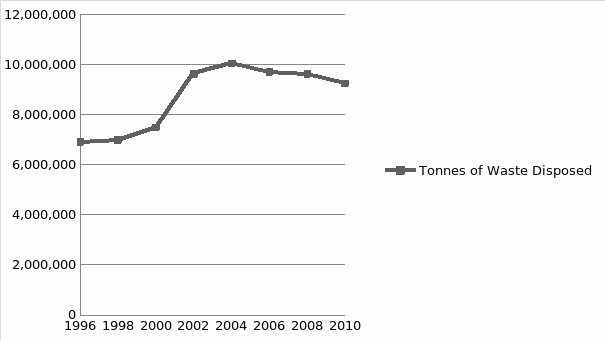
Waste disposal per capita also started to increase steadily from 621 kg per capita in 1996 and reached 809 kg per capita in 2004 (figure 3 and table 1). However, in subsequent years, the rate of waste disposal per capita declined and reached 699 kg per capita in 2010. The increment in waste disposal per capita in Ontario Province can be attributed to the growing population, production, and use of new, more complex materials that turn into waste materials before solutions are found. Changes in waste disposal are also accompanied by diverse waste compositions (Mavropoulos, n.d). The notable cases are reflected through changes brought about by various waste diversion campaigns such as Waste Electrical and Electronic Equipment (WEEE) program, Used Tires Programme, Blue Box Program Plan and Municipal Hazardous or Special Waste (MHSW) Programme to find new alternatives for recycling and reuse.
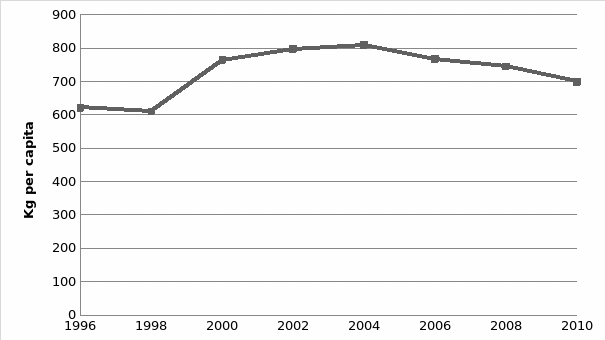
Until 1998, there were no records of waste diversion per capita in Ontario. Except for 1998, Ontario diverted wastes at a higher rate per capita than in any other years between 1996 and 2010 (Figure 3). For instance, the rate of diversion per capita was 28 percent but declined to 20 percent in 2002 (Figure 4), which could be attributed to the scope of waste definition and the introduction of new e-waste materials. Statistics Canada (2004) noted that previous data collected did not account for e-waste materials obtained from residential areas and other sources, but new data obtained from 2004 included such waste materials. Thus, in 2004, annual waste materials disposed of increased by 2.5 percent to 22.5 percent but recorded a low of 18.7 percent in 2006. In the following year, it rose to 22.6 percent, and any further improvement in 2010 was negligible (0.03 percent) (Figure 4).
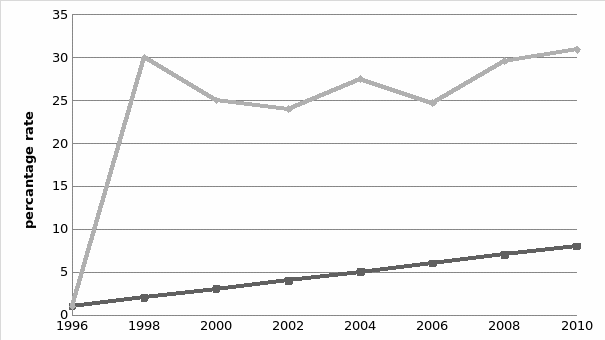
When Statistics Canada started to publish data on waste diversion, it became apparent that the program was effective between 2000 and 2006. Ontario diverted over 2.2 million tonnes of the total wastes generated in 2002. However, there were no records for wastes diverted between residential and non-residential sources until 2004. It reached a record high of 2.78 million tonnes in 2008 but has since declined to 2.74 million tonnes in 2010 (figure 5).
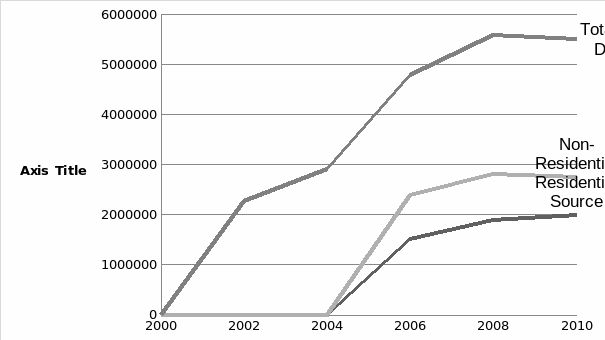
Note: There were no data for diverted waste materials between the year 1996 and 2000.
Although the Province of Ontario recorded impressive growth in waste diversion between 2002 and 2006, there was a major challenge afterward. That is, Ontario could not sustain the waste diversion program. Several factors could have contributed to this trend. First, the economic crisis of 2008 could have affected the investment in the industry negatively (Hook, 2009). According to Hook (2009), the solid waste industry has been regarded as recession-proof because the service is required throughout irrespective of prevailing economic conditions. However, the economic recession of 2008 had significant negative impacts on solid waste management.
It led to a low generation of waste materials. As a result, few resources were allocated for waste management. Moreover, the sector (private) experienced slow growth between 2008 and 2010 by adding only two new businesses with 380 new employees (table 3- see page 26). Second, the decline in waste diversion could have resulted from the exhaustion of the available resources and innovative strategies.
For instance, the Government of Ontario noted the current diversion program led to increased costs and a lack of innovative opportunities for the waste diversion program (Government of Ontario, 2013). Therefore, Ontario must focus on new ways of communicating, promoting, and emphasizing waste diversion between residential and non-residential waste generators because, in both cases, the trends have started to decline. Third, the slow growth in the sector could also affect waste diversion in Ontario. For instance, between 1996 and 2010, the waste management sector only added 110 new businesses and 3238 new employees (table 3 – see page 26). Hence, the waste management business in Ontario has not developed steadily with the increasing volumes of wastes generated.
A closer look at the volumes of wastes disposed of in landfills and volumes of wastes diverted show a huge disparity. For instance, in 2010, Ontario generated over 9 million tonnes of solid wastes but only diverted 2.7 million tonnes, which represented only 29.7 percent of the wastes (see Figure 6). In other words, huge volumes of generated solid wastes find their ways into landfills. This variation shows that Ontario has been slow in promoting waste diversion programs to waste generators and waste producers.
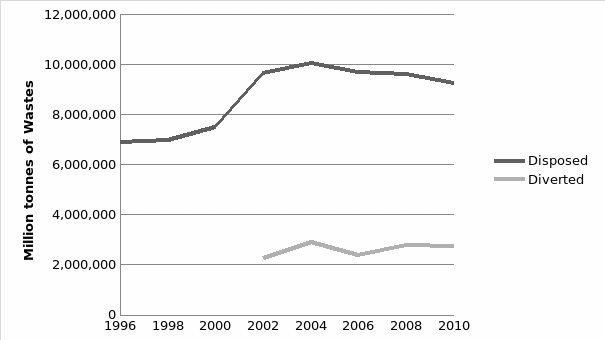
Although households may be managing some solid wastes at their backyard composters, the figures for such activities are not readily available and could be negligible against millions of tonnes of disposed of wastes. The diverted wastes only reflect wastes handled through central composting programs (Statistics Canada, 2013).
Ontario has recorded changes in the total of materials recycled or diverted. For instance, the rate of diversion declined from 2000 but rose in 2004, and in the subsequent years, it continued to decline but rose again in 2010. The Ministry of Environment (2008) had attributed such declines to poor diversion activities within industrial, commercial, and institutional sectors.
Industrial, commercial, and institutional sectors have diverted both hazardous and non-hazardous waste materials. However, between 2000 and 2010, tonnes of waste materials diverted in industrial, commercial, and institutional sectors inclined from 1.36 million tonnes to 0.75 million tonnes. The poor implementation of regulations on producer responsibility has led to a decline in rates of diversion among waste producers. For instance, individual companies do not have full responsibilities for their wastes but share such responsibilities with municipalities (Ministry of the Environment, 2009).
Non-residential sources (industrial, commercial, and institutional sectors) are the main generators of waste materials, and they dispose of huge tonnes of those materials than residential sources (Figure 7). This implies that non-residential sources of waste materials did not recycle, divert, or reuse most of the waste materials they generated. The focus of these data was on the rate of diversion, recycling, and reuse.
Figure 5 shows only waste materials diverted from landfills for both residential and non-residential sources. However, figure 7 highlights all waster materials from residential and non-residential sources that were diverted, reused, and recycled.
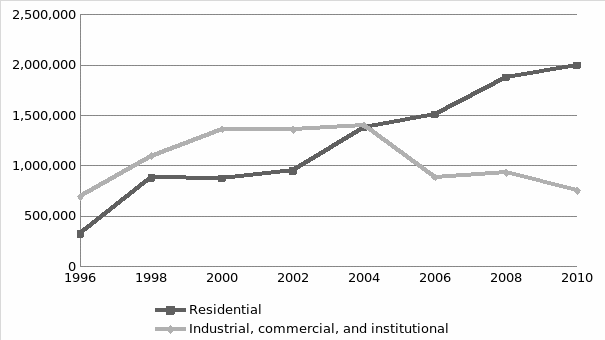
Waste producers can extend diversion responsibilities to residential sectors (Ministry of the Environment, 2009). These two factors associated with the extended producer responsibility could explain the decline in diversion rates in the non-residential sector.
Although non-residential sources are the largest generators of waste materials, their waste diversion practices were poor and did not facilitate waste diversion initiatives in Ontario (see Figure 8).
A comparison of waste diversion programs between non-residential sources and residential sources showed that residential sources diverted, recycled, or reused 73 percent of waste materials while industrial, commercial, and institutional sectors only managed to divert, recycle, or reuse 27 percent of the waste materials in 2010 (Figure 8).
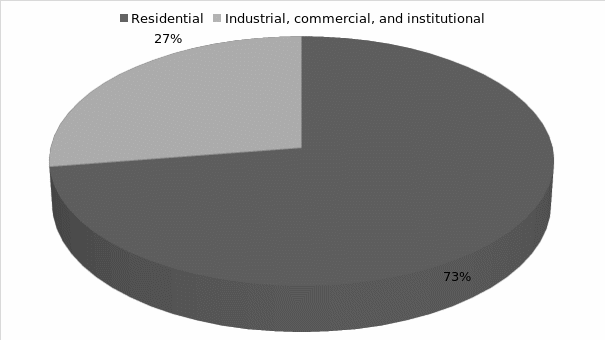
Ontario has recorded changes in the total of materials recycled or diverted. Since 2004, waste diversion in Ontario has declined. The Ministry of Environment (2008) attributed such declines to poor diversion activities within industrial, commercial, and institutional sectors. As a result, the overall waste diversion, recycling, or reuse processes in Ontario have experienced drawbacks.
Industrial, commercial, and institutional sectors have diverted both hazardous and non-hazardous waste materials (table 2). However, between 2000 and 2010, tonnes of waste materials diverted in industrial, commercial, and institutional sectors declined from 1.3 million tonnes to 0.7 million tonnes (Table 2). Such a rapid decline could only be attributed to poor waste diversion practices by the industrial, commercial and institutional sectors as other critics and the Ministry of the Environment had noted (Ministry of the Environment, 2008).
Table 2: Hazardous and non-hazardous waste diversion
On the other hand, residential waste diversion programs have achieved the desired objectives. For instance, between 1996 and 2010, residential waste diversion programs rose from 0.33 million tonnes to 1.99 million tonnes (figure 9). Hence, one can conclude that residential waste diversion initiatives have increased in Ontario. Conversely, industrial, commercial, and institutional sectors require new initiatives of managing and diverting wastes (Ministry of the Environment, 2009).
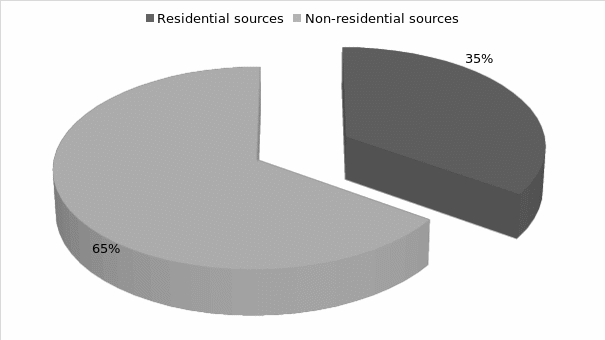
Table 3: No. of private business and employees in Ontario between 1996 and 2010
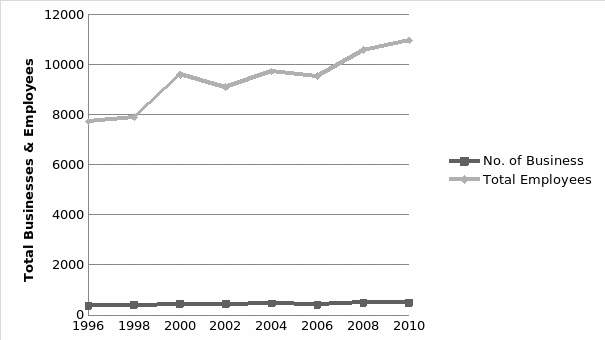
Waste management is a business in any city, and many businesses in the sector do well than government operations based on service provisions, resources, expenditure, revenues, and the number of employees in Ontario (table 3 and figure 10 and 11). Private waste management companies in Ontario seem to have invested heavily in the sector than the government (Statistics Canada, 2013). However, they are also many in a municipality compared to a single local authority, which is responsible for collecting and disposing of wastes in a given locality. As a result, private firms seem to have led to waste management in Ontario. Thus, Ontario needs to promote collaboration between the government and private businesses to drive its waste diversion agenda and control the volumes of wastes that go into the landfill.
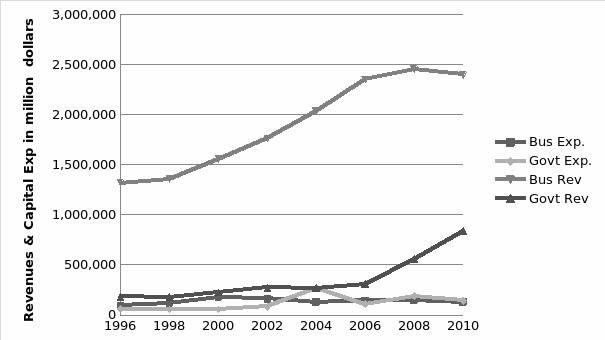
According to table 4, waste management firms in Ontario Province spend more relative to municipal waste management. In turn, businesses generate more revenues than the municipal. In addition, business expenditure depicts a high-level of effective use of financial resources. For instance, in the year 2010, business expenditure was roughly $128,424, while the government expenditure was $142,491, but a comparative analysis shows that business revenue was much more than government revenue.
Table 4: Private and Government expenditures and revenues in waste management
Effectiveness of the Programmes
Since the early 1980s, Ontario embarked on waste management programs to reduce pollution and the number of solid wastes that were taken to the landfill. Consequently, it made much progress on waste diversion too. From the data reviewed, Ontario’s progress on waste diversion has reached a phase of slow growth or decline. This has undermined the effectiveness of waste diversion programs. Therefore, Ontario must review its approaches to diversion, particularly the extended producer responsibility for waste producers, to support the diversion act and its 3Rs (Ontario needs to scrap its Waste Diversion Act, 2013). In addition, it must focus on the use science and technologies, engineering principles, and cost-effective approaches to enhance the program as many scholars have suggested (McBean et al., 1994; Oweis and Khera, 1990; Worrell et al., 2011; LaGrega, Buckingham, and Evans, 2010).
It extended greater responsibilities to waste generators instead of producers. This can enhance waste diversion, reduce the number of solid wastes for landfill, and create jobs in Ontario (Conference Board of Canada, 2014).
Ontario introduced several programs under the Waste Diversion Act to change its waste management and diversion strategies. These were mainly the 3Rs. The programs also focused on waste producers to some extent by holding that such producers should bear costs related to the negative impacts of wastes on the environment. Ontario should review its waste diversion strategies with regard to producers’ responsibilities. It extended greater responsibilities to waste generators.
However, Ontario must focus on reducing landfill wastes. There are some existing challenges with the current waste diversion program and the Act itself. Therefore, the Province must evaluate the framework, define new features, and the next course of action for waste management and diversion.
The Province must realize that waste management is an evolving and growing field based on new forms of wastes, technologies, and regulatory requirements.
Conclusion
The waste diversion programs in Ontario have worked, but they face some challenges, which require evaluation of the current framework and definition of a new waste diversion program. Overall, the new framework must be cost-effective, user-friendly, based on engineering principles, science and technologies, and the industry best practices. It is imperative to focus on 3Rs. Ontario needs to encourage waste producers to enhance waste diversion.
The current waste diversion puts much emphasis on waste generators and less on original manufacturers (waste producers) of materials. This would ensure that waste producers find innovative approaches to developing materials and diversion techniques. Managing municipal solid waste is a complex process. Waste management practices continue to evolve as new forms of wastes emerge, and global conditions change. To comprehend such dynamics, waste management professionals must understand sources and generators of wastes, waste characteristics, scientific and engineering principles, laws and regulations, and cost-effective approaches.
Recommendation
- There is a need to enhance data collection among waste producers and generators based on their diversion activities. There are missing data, particularly in waste producer responsibility in waste diversion.
- The new framework should also promote waste diversion based on materials or sectors. This would ensure that waste diversion programs meet some specific conditions, focus on specific wastes, or promote the development of programs like the Blue Box and Municipal Hazardous Waste programs.
Such programs could offer many benefits to the Province.
- Reuse centers should offer free materials for the public under product exchange programs.
- The focus should be on reducing the costs of waste disposal by bulking materials
- Convenient facilities also reduce costs of transportation by transporting full loads rather than small pieces
- Waste management facilities should be able to handle volumes of wastes from a specific municipality.
References
American Public Works Association. (1961). Municipal Refuse Disposal. Washington, DC: APWA. Web.
American Public Works Association. (1941). Refuse collection practice (3rd ed). Washington, DC: American Public Works Association. Web.
Diaz, L.F., Savage, G.M., Eggerth, L.L., and Golueke, C.G. (1993). Composting and Recycling: Municipal Solid Waste. London: Lewis Publishers. Web.
Government of Ontario. (2013). Waste Reduction Strategy. Web.
Hook, B. R. (2009). Recession impacts solid waste industry. Web.
LaGrega, M., Buckingham, P., and Evans, J. (2010). Hazardous Waste Management. New York: McGraw-Hill. Web.
MacBride, S. (2013). San Francisco’s Famous 80% Waste Diversion Rate: Anatomy of an Exemplar. Web.
Mavropoulos, A. (n.d). Waste Management 2030+. Web.
McBean, E., Farquhar, G., and Rovers, F. (1994). Solid Waste Landfill Engineering and Design. Upper Saddle River: Prentice Hall. Web.
Ministry of the Environment. (2008). Toward a Zero Waste Future: Review of Ontario’s Waste Diversion Act, 2002. Web.
Mueller, W. (2013). The effectiveness of recycling policy options: Waste diversion or just diversions? Waste Management, 33(3), 508–518. Web.
Noble, G. (1992). Siting Landfills and Other LULUs. Lancaster, Pennsylvania: Technomic Publishing Company, Inc. Web.
Ontario needs to scrap its Waste Diversion Act. (2013). On-Site Magazine. Web.
Oweis, I. S., and Khera, R. P. (1990). Geotechnology of waste management. Boston: PWS Publishing. Web.
Pavoni, J., Heer, J., and Hagerty, J. (1975). Handbook of solid waste disposal: materials and energy recovery. New York: Van Nostrand Reinhold Co. Web.
Reddi, Lakshmi and Inyang, Hilary I. (2000). Geoenvironmental Engineering: Principles and Applications. Madison: Marcel Dekker, Inc. Web.
Shah, K. L. (2000). Basics of solid and hazardous waste management technology. Upper Saddle River: Prentice Hall. Web.
Statistics Canada. (1999). Waste Management Industry Survey: Business and Government Sectors, 1996. Ottawa, ON: System of National Accounts. Web.
Statistics Canada. (2000). Waste Management Industry Survey: Business and Government Sectors, 1998. Ottawa, Ontario: Environment Accounts and Statistics Division. Web.
Statistics Canada. (2003). Waste Management Industry Survey : Business and Government Sectors, 2000. Ottawa, Ontario: Minister of Industry. Web.
Statistics Canada. (2004). Waste Management Industry Survey : Business and Government Sectors, 2002. Ottawa, ON: Minister of Industry. Web.
Statistics Canada. (2007). Waste Management Industry Survey: Business and Government Sectors. Ottawa, Ontario: Minister of Industry. Web.
Statistics Canada. (2008). Waste Management Industry Survey: Business and Government Sectors, 2006. Ottawa, Ontario: Minister of Industry. Web.
Statistics Canada. (2010). Waste Management Industry Survey: Business and Government Sectors, 2008. Ottawa, Ontario: Minister of Industry. Web.
Statistics Canada. (2013). Waste Management Industry Survey: Business and Government Sectors, 2010. Ottawa: Minister of Industry. Web.
Williams, P. T. (2005). Waste Treatment and Disposal (2nd Ed.). New York: John Wiley & Sons, Inc. Web.
Worrell, W., and Vesilind, P. (2011). Solid Waste Engineering. Connecticut: Cengage Learning. Web.